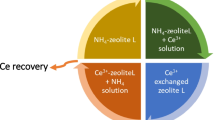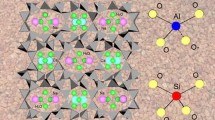Abstract
Dechlorination of eutectic LiCl–KCl based electrorefiner (ER) salt is reported via ion-exchange reaction with protonated ultrastable Y-type (USHY) zeolite bound into mechanically fluidized 45–250 μm diameter particles. Evidence of exchange of cations from the salt (Li+, K+, and fission product cations) into the zeolite lattice replacing H+ ions was found based on a change in unit cell size, ICP-MS, XRD and TEM–EDS in addition to detection of HCl off gas. Ion exchange reaction was carried out at 625 and 650 °C, temperatures above the melting point of eutectic LiCl–KCl. Experiments were carried out to optimize zeolite drying temperature, estimate maximum ion-exchange capacity, and determine the thermal stability of USHY zeolite. The results indicate over 90% dechlorination can be achieved without zeolite structure collapse at 625 °C. This provides a promising route to stabilizing waste from radioactive chloride salts into dechlorinated waste forms for permanent geologic disposal.










Similar content being viewed by others
References
Cochran TB, Feiveson HA, Patterson W, Pshakin G, Ramana MV, Schneider M, von Hippel F (2010) Fast breeder reactor programs: history and status. International Panel on Fissile Mater (IPFM)
Seo CS, Park BH, Park SB, Jung KJ, Park SW, Kim SH (2006) Study on the characteristics of the ion exchange of zeolite 4A in a molten LiCl system. J Chem Eng Jpn 39(1):27–33
Lewis MA, Fischer DF, Smith LJ (1993) Salt-occluded zeolites as an immobilization matrix for chloride waste salt. J Am Ceram Soc 76(11):2826–2832
Simpson MF, Goff KM, Johnson SG, Bateman KJ, Battisti TJ, Toews KL, Sinkler W (2001) A description of the ceramic waste form production process from the demonstration phase of the electrometallurgical treatment of EBR-II spent fuel. Nucl Technol 134(3):263–277
Priebe S, Bateman K (2008) The ceramic waste form process at Idaho National Laboratory. Nucl Technol 162(2):199–207
Simpson MF, Barber DB, Benedict RW, Teske GM (2006) EBR-II and FFTF Spent Fuel Processing Options Report, Idaho National Laboratory
U.S. Department of Energy (2000) Record of decision for the treatment and management of sodium bonded spent nuclear fuel. Federal Register 65(182):56565–56570
Riley BJ, Rieck BT, McCloy JS, Crum JV, Sundaram SK, Vienna JD (2012) Tellurite glass as a waste form for mixed alkali–chloride waste streams: candidate materials selection and initial testing. J Nucl Mater 424(1–3):29–37
Kalogeras IM, Vassilikou-Dova AB (1998) Electrical properties of zeolitic catalysts. In: Defect and diffusion forum, vol 164. Trans Tech Publications, pp 1–36
Katz JJ, Rabinowitch E (1951) The chemistry of uranium, vol 1. McGraw-Hill, New York
Lexa D, Johnson I (2001) Occlusion and ion exchange in the molten (lithium chloride–potassium chloride–alkali metal chloride) salt + zeolite 4A system with alkali metal chlorides of sodium, rubidium, and cesium. Metall Mater Trans B 32(3):429–435
Ahluwalia RK, Geyer HK, Pereira C, Ackerman JP (1998) Modeling of a zeolite column for the removal of fission products from molten salt. Ind Eng Chem Res 37(1):145–153
Jia C et al (1993) Solid-state exchange of lanthanum in beta zeolite. Appl Catal. A Gener 106(2):L185–L191
Nassar Eduardo J, Serra Osvaldo A (2002) Solid state reaction between europium III chloride and Y-zeolites. Mater Chem Phys 74(1):19–22
Bagri P, Simpson MF (2015) Occlusion and ion exchange of eutectic LiCl–KCl in HY zeolite. J Nucl Fuel Cycle Waste Technol 13(1):45–53
Kerr GT (1968) Chemistry of crystalline aluminosilicates. V. Preparation of aluminum-deficient faujasites. J Phys Chem 72(7):2594–2596
Kerr GT (1969) Chemistry of crystalline aluminosilicates. VI. Preparation and properties of ultrastable hydrogen zeolite Y. J Phys Chem 73(8):2780–2782
Maher PK, Hunter FD, Scherzer J (1971) Crystal structures of ultrastable faujasites. Adv Chem Ser 101:266–278
Simpson MF, Battisti TJ (1999) Adsorption of eutectic LiCl–KCl into zeolite 4A using a mechanically fluidized vacuum system. Ind Eng Chem Res 38(6):2469–2473
Breck Donald W (1984) Zeolite molecular sieves: structure, chemistry and use. Krieger, Malabar
Price L, Leung KM, Sartbaeva A (2017) Local and average structural changes in zeolite a upon ion exchange. Magnetochemistry 3(4):42
Leszczyński M, Litwin-Staszewska E, Suski T, Bąk-Misiuk J, Domagała J (1995) Lattice constant of doped semiconductor. Acta Phys Pol A 88(5):837–840
Acknowledgements
This research has been funded by the U.S. Department of Energy through the Nuclear Energy University Program (Project 16-10190).
Author information
Authors and Affiliations
Corresponding author
Ethics declarations
Conflict of interest
The authors declare that there is no conflict of interests regarding the publication of this paper.
Data availability
The datasets generated during and analyzed during the current study are available from the corresponding author on reasonable request.
Additional information
Publisher's Note
Springer Nature remains neutral with regard to jurisdictional claims in published maps and institutional affiliations.
Rights and permissions
About this article
Cite this article
Wasnik, M.S., Grant, A.K., Carlson, K. et al. Dechlorination of molten chloride waste salt from electrorefining via ion-exchange using pelletized ultra-stable H-Y zeolite in a fluidized particle reactor. J Radioanal Nucl Chem 320, 309–322 (2019). https://doi.org/10.1007/s10967-019-06476-y
Received:
Published:
Issue Date:
DOI: https://doi.org/10.1007/s10967-019-06476-y




